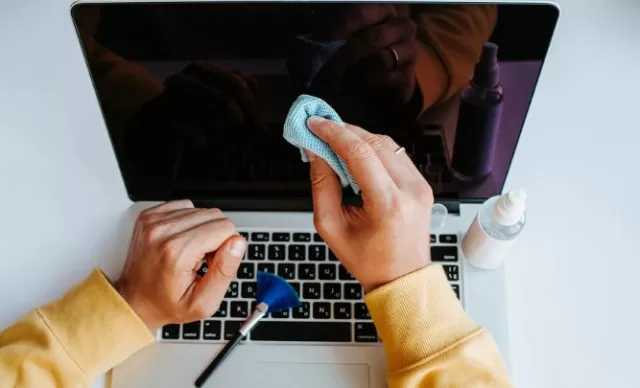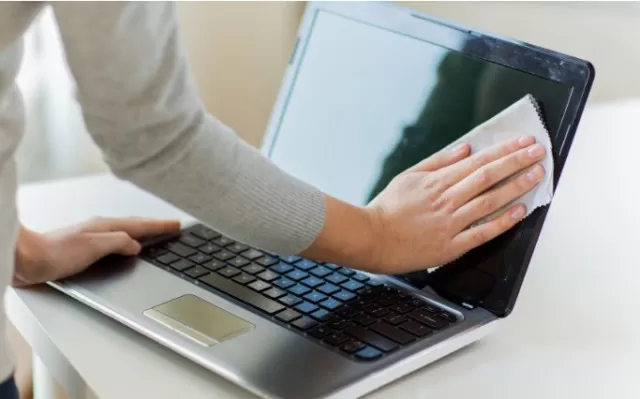Cleaning Computer and Laptop Screens for Clear Display. Computer and Laptop Screens can quickly accumulate dust, smudges, and other debris that can leave your display blurry or damaged.
Computer and laptop screens can quickly accumulate dust, smudges, and other debris, leading to a blurry or damaged display. Proper cleaning is essential, and the first step is determining the type of screen you have—glass-coated or non-glass-coated—since each requires different care. Glass-coated screens, found on newer Apple products, are sturdier than non-glass-coated LCD or LED screens, which appear more matte and are more easily damaged if not cleaned correctly.
Cleaning Computer – How to Prep Your Screen for Proper Cleaning

If you’re unsure about your screen type, check the manufacturer’s website or manual before cleaning to avoid costly damage.
Always choose gentle cleaning methods for non-glass-coated screens. Here are some additional tips to keep in mind for any screen:.
Avoid using paper towels or tap water, which can scratch or damage the screen.
Use a lint-free microfiber cloth and distilled water for cleaning. Don’t spray any cleaner or water directly on the screen or allow moisture to enter ports or controls.
Be gentle and avoid scrubbing or wiping in circles. Avoid harsh cleaners, such as ammonia, bleach, or scouring powder.
Power down and turn off the screen before cleaning. .
Cleaning Computer – Cleaning Glass-Covered Computer and Laptop Screens

Power down and wipe away dust and smudges from computer and laptop screens.
To clean a computer monitor or laptop screen, start by powering down and turning off the device to avoid electrical mishaps.
A black screen also makes it easier to see the dust and smudges. Then, use a clean microfiber cloth to gently wipe away dust from the screen, starting at the top and wiping side to side before switching to a clean side and wiping from top to bottom.
For stuck-on grime, use a clean, dampened microfiber cloth with a few drops of distilled water or isopropyl rubbing alcohol to apply light pressure to the screen.
Afterward, dry the screen using a clean, dry microfiber cloth.
To clean the screen housing, use the previously dampened microfiber cloth or a disinfecting wipe to clean and dust the area around the screen.
Cleaning Tips for Non-Glass-Covered Computer and Laptop Screens

Cleaning Non-Glass-Covered Computer and Laptop Screens.
Power down and unplug or turn off the screen/laptop.
Remove dust using a clean, dry microfiber cloth.
Wipe from top to bottom with gentle pressure and continue dusting with a clean side as the cloth gets soiled.
Wipe away smudges with a slightly damp microfiber cloth.
Use distilled water only and wipe smudged areas with a light touch and gentle pressure.
For stuck-on grime, mix one part distilled water and one part isopropyl alcohol.
Spritz the solution on a clean microfiber cloth and wipe the dirty areas gently.
Dry the screen immediately with another clean, dry microfiber cloth.
To clean the screen housing, wipe away dust and grime with the previously dampened microfiber cloth.
For disinfection, use a nearly dry disinfectant wipe to clean the housing, keyboard, and peripherals.
In addition to the steps outlined in the previous section, there are a few additional tips to keep in mind when cleaning non-glass-covered computer and laptop screens.
First, never use any kind of cleaner that contains ammonia, bleach, or other harsh chemicals. These can damage the screen’s coating or cause discoloration. Stick to distilled water and isopropyl alcohol solutions, as recommended earlier.
Second, avoid using rough or abrasive materials like paper towels or cloths made from materials like polyester or cotton.
These can scratch the screen and cause permanent damage. Instead, stick to soft microfiber cloths, which are gentle and won’t leave behind any lint or fibers.
Finally, if you’re having trouble removing stubborn grime or fingerprints, try using a dedicated screen-cleaning solution. These are designed specifically for use on electronic screens and can help to break down oils and smudges without damaging the surface.
Just be sure to follow the instructions carefully and use a clean microfiber cloth to apply the solution, avoiding any direct contact with the screen.